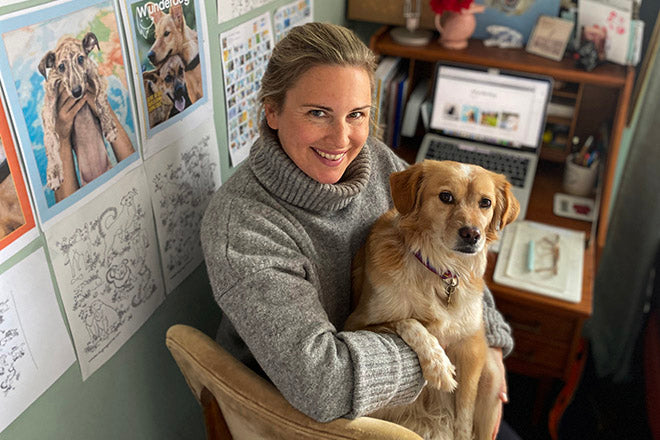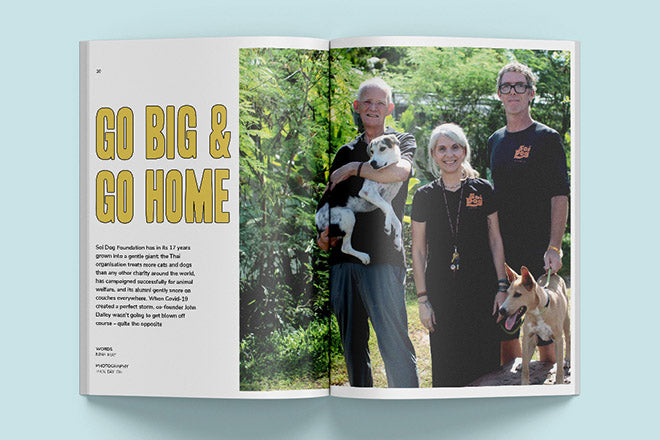
Nina May, Wunderdog
Copy editor Nina May launched Wunderdog in 2016 as a website, inspired by her rescue dog, Pippa; after a brief delay to look after the terminally ill Pippa, the print edition of Wunderdog followed in 2019. We meet her as the redesigned issue three arrives in shops.
How do you start your week?
My week starts like every day: make coffee (filter), feed the dogs, and take them for a walk. Pets don’t care what day of the week it is. Since I work from home or my nearby co-working space, I have the luxury of not commuting.

Describe the state of your desk and what you can see in your studio/office
With all the coronavirus stuff around, I have not been to my London co-working space, the De Beauvoir Block, much. My desk is tiny, but I love writing on it. For proofreading and signing off layouts, I relocate to the kitchen table.

I like beautiful, silly, old things. So, my mid-century bureau (in my bedroom) is full of stuff: flowers from the garden, a portrait of my late dog Pippa, and a vintage letter-holder in the shape of a dachshund full of notes and pictures. To the side, I can see out the window, but the proper window seat is for my dog. Goldie rules.
On the Wunderwall next to me are cover options, the flatplan and an illustration pattern I commissioned for a Christmas 2020 gift box. It features Wunderdogs from issues one and two, and the colouring-book style work was produced by Elle Sorridente.

Which magazine do you first remember?
Vogue. My late aunt was in fashion. I would make tiny Vogues, the size of a quarter of a postcard for her when I was six and stayed at hers for a special weekend.
But if I may give a special shout-out to another title, it’s The Idler. I discovered it when I was a Blur-loving teenager living in Germany. Alex James had written for it, and it was a hell of a job to track down a copy.
Back then, The Idler published when it published (true to idling styling) and was based on Parkway in Camden. I thought any city that was home to a magazine like The Idler is a good place, so the title was one of the reasons why I moved to London.

Which magazine matters to you the most right now?
I subscribe to Delayed Gratification, which remains the strongest independent title in my view. In our time of ‘fake news’, surely we can’t benefit enough from perspective. Its co-founder, Rob Orchard, has also been very kind and helped me when I had a ton of questions about launching my magazine.

I also love New Philosopher, because it succeeds in making an extremely dry subject a thing of beauty. Studio Carreras designs striking covers for big questions, and the contents is lively and engaging.
Tell us about the first dog you remember.
I grew up with a little wire-haired dachshund, Biene (German for ‘bee’). Typically for that breed, she had soft grey hair on her head from a young age. I would sometimes make a bed for her in my mum’s drawers, throwing all her underwear on the floor to make room. Dog always came first!
Biene was the dog of my childhood – we got her when I was two years old, and she lived to the grand old age of 14. She was family, as dogs should be.

Describe Wunderdog mag in three words.
My pet project.
Who are your readers?
Dog lovers times ten! I think there are people who have a dog like they have a sofa, and they don’t think much about animals and their welfare. And then there are Wunderdog readers, who care about animals and the planet, who are active in the charities they adopted their dogs from, and who – like me – never shut up about dogs.
In that sense, we are all similar. I would like to think that all Wunderdog readers could meet up and would get on famously.
Geographically, London, New York and Toronto are the key metropolitan areas. I am pleased to say that I have also have subscribers outside the cities – in the UK, I have subscriber-clusters in the West Country as well as in Scotland.

I also want to give a shout-out to my distributor, Ra & Olly. They got me into Magalleria in Bath and Athenaeum in Amsterdam straight away. Wunderdog is also stocked at Magma in London, Papercut in Stockholm (above) and – soon – at MagNation in Auckland.

The magazine does a great job of celebrating rescue dogs and their owners; is there a wider agenda to the project?
Yes, I sometimes pompously call it a ‘media brand’, so there will be more branches apart from the website and magazine. Books and an annual children’s edition (Wunderpup) are obvious ways to help people who want to learn more about adopting dogs and educating this and the next generation about dog welfare.
I am also planning a non-profit app that gives back to rescue charities, and I would like to do walking events. Alas, with Covid-19, I don’t see events taking off any time soon, even if they are outside. People would still have to travel there.

Tell us about the redesign of Wunderdog; what did you set out to do, and what has it achieved?
I attended the magCulture conference 2014 with the idea of a dog magazine – and the first edition of Wunderdog ran off the press in 2019. That’s how long I have been sitting on it – and all because I never had an art director as a partner. Magazines should always have both: an editor and an art director. If it’s mainly images, it’s a portfolio; if it’s mainly words, it’s a book.
When I thought I had found one, in 2018, they let me down at the design stage. I had by that time commissioned lots of people and ran up costs of a few thousand pounds to contributors. I had a massive breakdown. Thankfully, a friend introduced me to a small design agency that was willing to take on Wunderdog. I ended up publishing issues one and two with the agency, which did a fantastic job of laying out a completely new publication.
But that partnership element was still missing – I don’t want to be a ‘client’ to a ‘service provider’; I want a partner who tells me off when I do something stupid.

I put out a question for a new art director on The Dots, and Alice Daisy Pomfret (above) was one of the respondents. I sent her a folder of 600 images from my Scotland travel story and asked her how she would design it. Alice’s redesign was spot on.
We decided to work together, and I asked Alice to redesign Wunderdog to make it bolder and cleaner. Alice also suggested restructuring the chapters and had other ideas for Wunderdog.

I can’t tell you how excited I was to read her proposal: for the first time, an art director really thought about Wunderdog, how it should look and flow, and went beyond what I’d envisioned or asked for. Because of the travel restrictions, we’ve only met once, in her hometown of Norwich.
It really feels more like a partnership – although Alice still hasn’t told me off for anything :-)

Share one piece of publishing/business advice that has helped you.
Have a North Star, and make it as small as the dot you can see in the sky. Wunderdog is about rescue dogs. It’s not about dogs or animals at large, it’s about rescue dogs.
That’s my North Star. Be specific. And if some people are not interested in your direction of travel, that’s ok.
Looking ahead, what are you excited about this week?
This is a huge week! Issue three is launching – culminating in our window at magCulture! I enjoy sending out subscriptions myself, so I’ll be writing notes and stuffing envelopes on my kitchen table. If any envelopes include fluff from my dog Goldie’s magnificent plume, I apologise in advance!
We’re also launching our Christmas bundle. Illustrator Elle Sorridente has produced a beautiful dog pattern for us, featuring wunderdogs from the first two issues, in a colouring-book style. We have applied her pattern to a luxurious box and a cotton tote bag. The gift set includes all issues of Wunderdog.


